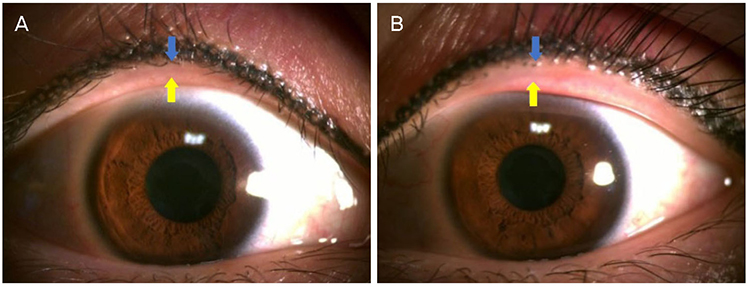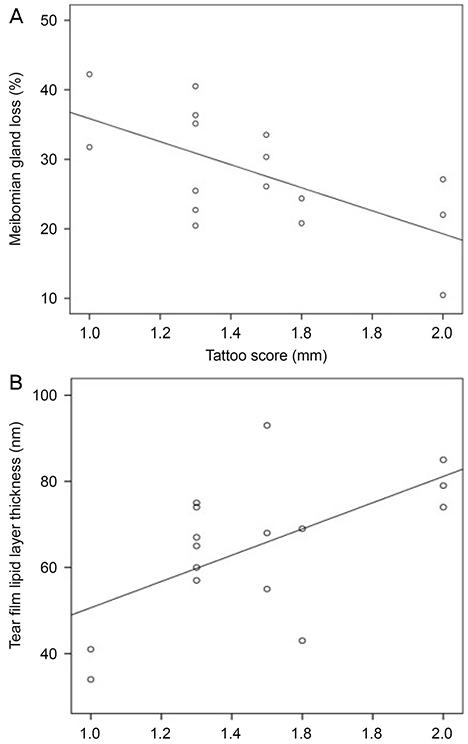J Korean Ophthalmol Soc.
2020 Feb;61(2):146-152. 10.3341/jkos.2020.61.2.146.
The Effect of Eyeliner Tattoo on Meibomian Gland Dysfunction and the Ocular Surface
- Affiliations
-
- 1The Institute of Ophthalmology and Optometry, Department of Ophthalmology, Ewha Womans University Mokdong Hospital, Ewha Womans University College of Medicine, Seoul, Korea. hkeoph@gmail.com
- 2Department of Ophthalmology, Samsung Medical Center, Sungkyunkwan University School of Medicine, Seoul, Korea.
- 3The Institute of Ophthalmology and Optometry, Department of Ophthalmology, Ewha Womans University Seoul Hospital, Ewha Womans University College of Medicine, Seoul, Korea.
- KMID: 2470736
- DOI: http://doi.org/10.3341/jkos.2020.61.2.146
Abstract
- PURPOSE
To determine whether eyeliner tattoo affects the meibomian gland (MG) and ocular surface.
METHODS
The medical charts of an eyeliner tattoo group (16 eyes of 8 patients) and a control group (16 eyes of 18 patients) were retrospectively reviewed. The ocular surface disease index questionnaire, ocular surface staining score, tear film break-up time (TBUT), upper eyelid abnormality, meibum expressibility and quality, and MG loss and tear film lipid layer thickness (LLT) which measured with LipiView® (TearScience, Morrisville, NC, USA) were compared. In the tattoo group, the correlation between the distance from the MG orifice to the tattoo pigment and other indices were analyzed.
RESULTS
Compared to controls, the tattoo group had a significantly higher ocular surface disease index (p = 0.002), shorter TBUT (p < 0.001), higher vessel engorgement of the upper lid (p = 0.016), poorer meibum expressibility and quality (p = 0.006 and p < 0.001, respectively), higher MG loss (p < 0.001), and thinner LLT (p = 0.024). In the tattoo group, the closer the tattoo was to the MG orifice, the more the upper lid vessel was engorged and the more MG loss occurred (r(s) = −0.560, p = 0.024; r(s) = −0.563, p = 0.023, respectively), and a thinner LLT was observed (r(s) = 0.567, p = 0.022).
CONCLUSIONS
Eyeliner tattoos may be related to changes in the lid margin, loss of the MG, and thinning of the LLT.
Figure
Reference
-
1. Craig JP, Nichols KK, Akpek EK, et al. TFOS DEWS II Definition and Classification Report. Ocul Surf. 2017; 15:276–283.
Article2. Foulks GN, Bron AJ. Meibomian gland dysfunction: a clinical scheme for description, diagnosis, classification, and grading. Ocul Surf. 2003; 1:107–126.
Article3. Nelson JD, Shimazaki J, Benitez-del-Castillo JM, et al. The international workshop on meibomian gland dysfunction: report of the definition and classification subcommittee. Invest Ophthalmol Vis Sci. 2011; 52:1930–1937.
Article4. Wojtowicz JC, Butovich IA, McCulley JP. Historical brief on composition of human meibum lipids. Ocul Surf. 2009; 7:145–153.
Article5. Kim EC. Diagnosis and treatment of dry eye syndrome. J Korean Med Assoc. 2018; 61:352–364.
Article6. Eom Y, Lee JS, Kang SY, et al. Correlation between quantitative measurements of tear film lipid layer thickness and meibomian gland loss in patients with obstructive meibomian gland dysfunction and normal controls. Am J Ophthalmol. 2013; 155:1104–1110.
Article7. Finis D, Pischel N, Schrader S, Geerling G. Evaluation of lipid layer thickness measurement of the tear film as a diagnostic tool for Meibomian gland dysfunction. Cornea. 2013; 32:1549–1553.
Article8. Kojima T, Dogru M, Matsumoto Y, et al. Tear film and ocular surface abnormalities after eyelid tattooing. Ophthalmic Plast Reconstr Surg. 2005; 21:69–71.
Article9. Lee YB, Kim JJ, Hyon JY, et al. Eyelid tattooing induces meibomian gland loss and tear film instability. Cornea. 2015; 34:750–755.
Article10. Gomes JAP, Azar DT, Baudouin C, et al. TFOS DEWS II iatrogenic report. Ocul Surf. 2017; 15:511–538.
Article11. Tomlinson A, Bron AJ, Korb DR, et al. The international workshop on meibomian gland dysfunction: report of the diagnosis subcommittee. Invest Ophthalmol Vis Sci. 2011; 52:2006–2049.
Article12. Bron AJ, Evans VE, Smith JA. Grading of corneal and conjunctival staining in the context of other dry eye tests. Cornea. 2003; 22:640–650.
Article13. Arita R, Itoh K, Maeda S, et al. Proposed diagnostic criteria for obstructive meibomian gland dysfunction. Ophthalmology. 2009; 116:2058–2063.e1.
Article14. Kim HM, Eom Y, Song JS. The relationship between morphology and function of the meibomian glands. Eye Contact Lens. 2018; 44:1–5.
Article15. Takahashi Y, Watanabe A, Matsuda H, et al. Anatomy of secretory glands in the eyelid and conjunctiva: a photographic review. Ophthalmic Plast Reconstr Surg. 2013; 29:215–219.16. Shams PN, Ortiz-Pérez S, Joshi N. Clinical anatomy of the periocular region. Facial Plast Surg. 2013; 29:255–263.
Article17. Morrison C, Zuckerman S. My tattoos caused my dry eye? A new way to look at diagnosis and treatment for patients with tattoo eyeliner. Can J Optom. 2016; 78:6–15.18. Goldman A, Wollina U. Severe unexpected adverse effects after permanent eye makeup and their management by Q-switched Nd:YAG laser. Clin Interv Aging. 2014; 9:1305–1309.19. Liao JC, Proia AD, Ely PH, Woodward JA. Late-onset melanopenic hypomelanosis as a complication of cosmetic eyeliner tattoo. J Am Acad Dermatol. 2013; 69:e144–e146.
Article20. Wolfley DE, Flynn KJ, Cartwright J, Tschen JA. Eyelid pigment implantation: early and late histopathology. Plast Reconstr Surg. 1988; 82:770–774.21. Tse DT, Folberg R, Moore K. Clinicopathologic correlate of a fresh eyelid pigment implantation. Arch Ophthalmol. 1985; 103:1515–1517.
Article22. Bron AJ, Benjamin L, Snibson GR. Meibomian gland disease. Classification and grading of lid changes. Eye (Lond). 1991; 5(Pt 4):395–411.
Article
- Full Text Links
- Actions
-
Cited
- CITED
-
- Close
- Share
- Similar articles
-
- Risk Factors of Meibomian Gland Loss in Dry Eye Disease
- Comparison of Changes in Ocular Surface Status after Wearing Orthokeratologic and Rigid Gas Permeable Lens
- Therapeutic Effect of Intense Pulsed Light of Dry Eye with Meibomian Gland Dysfunction
- Effects and Prognostic Factors of Automated Thermodynamic System Treatment for Meibomian Gland Dysfunction
- Clinical Efficacy of Rebamipide Eyedrops in Patients with Sjögren’s Syndrome Accompanied by Meibomian Gland Dysfunction




